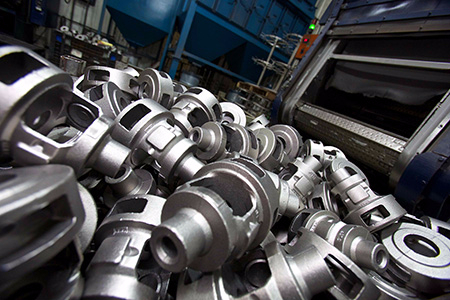
Have a big batch of metal parts that need finishing? Here’s a solution: let’s get blasted!
Well, we don’t mean that literally, of course. Our brand of blasting is all about cleaning and strengthening the surface of metal parts! We offer a wide range of metal finishing and surface preparation processes, including shot blasting ‒ one of the fastest and most effective ways to clean metal to a mirror-shine.
Shot blasting is a set of technical processes designed to remove various impurities from metal surfaces. We use it to clean contaminants like dirt and oil from mass quantities of parts at once. It’s also a highly efficient method of removing metal oxides like rust or mill scale.
Shot blasting is an important step in preparing metal parts for painting, powder coating or other coating methods that require a clean surface in order to stick. It is practically mandatory in many industries, including the automotive, metal manufacturing, aviation, shipbuilding industries, as well as foundries and the production of welded structures.
Latem Industries utilizes various methods to meet our customers’ specific shot blasting requirements. Here, we’ll compare the applications and advantages of two of the shot blasting methods we offer: tumble blasting and index table blasting.
1. Tumble Blasting
Tumble blast machines are comprised of either a rubber or steel belt that’s driven within an enclosed blasting cabinet. Metal components are placed into the blasting cabinet in batches, where they are continuously impacted by one or more high-pressure streams of abrasive materials (called shots or blasting media.)
We can vary the type, shape, size and density of the abrasive materials to achieve different results. The metal abrasives we utilize in tumble blasting include steel grit, copper shots and aluminum pellets.
During the tumble blasting process, the metal components are also continuously bumping against each other to help knock off surface contaminants and defects.
Advantages of Tumble Blasting
One of the biggest advantages of tumble blasting is the ability to deliver a consistent finish. The combination of tumbling and blasting ensures that even components with difficult geometry (deep recesses or tight angles) receive a perfect surface preparation.
Tumble blasting also allows components to impact each other, accelerating the removal of burrs and sharp edges.
2. Index Table Blasting
Index table blast machines are comprised of a blasting chamber with a large, circular turntable and several smaller ‘satellite’ tables attached to the turntable’s surface.
One or more metal components can be attached to each satellite table. As the large table rotates on its axis, the satellite tables move along within it. Each table can rotate on its own axis independently.
The Index blast table machine we use at Latem Industries is divided into thirds, with a satellite table in each section. A typical blasting operation using this equipment goes like this:
One section of the turntable is loaded with components for shot blasting. The table then indexes or turns, moving the loaded table into the blast chamber for finishing.
As the first section enters the chamber, the second section moves from the chamber into the loading area. The second section is loaded with another set of parts. This step is then repeated to move the second section into the chamber and expose the third and final section.
When the table indexes a third time, completing a full rotation, the first section emerges from the blasting chamber with a stack of finished components. The processed parts are removed, and the is section loaded with a fresh batch of components.
This process is continually repeated until all of the parts that require processing have been finished.
Advantages of Index Table Blasting
Index table blasting allows us to process rotationally symmetrical shapes in large batches. The operation is well-suited for components that are fragile and cannot withstand the impact of hitting against each other in a tumble blasting operation. Some of the common applications include cleaning, finishing and deburring of axles, draft shafts and gear assembles.
Tumble Blast vs. Index Table Blast: Which One’s Right For You?
We deliver solutions to most every metal finishing challenge with industry-leading results. To learn more about tumble blasting and index table blasting and find out how we can reduce your processing costs, contact the experts at Latem Industries today!

